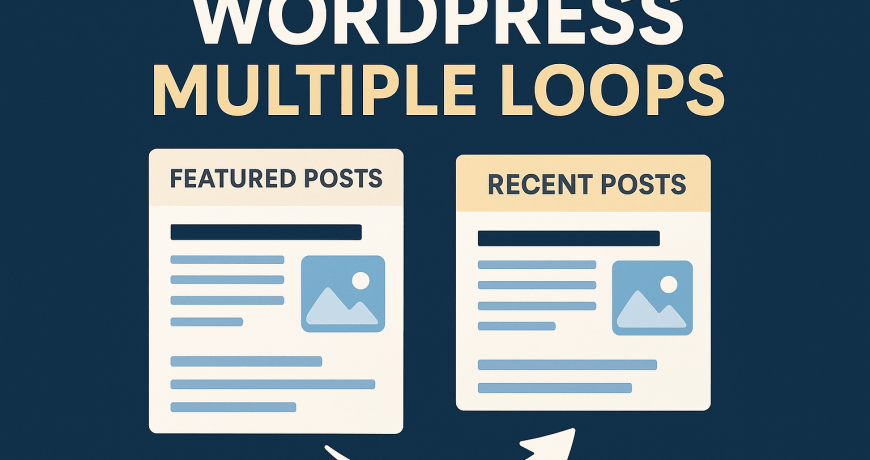In WordPress theme development, the Loop is the core mechanism that displays posts. However, sometimes you need to show different types of content on the same page — for example, featured posts on top and recent posts below. That’s where WordPress Multiple Loops come in.
Mastering multiple loops helps you build dynamic layouts, custom pages, and category-based sections — essential skills for creating professional WordPress websites.
If you’d rather have experts handle your website’s structure, Webful Creations offers complete WordPress design services, including custom loop implementation, theme development, and performance optimization.
What Is the WordPress Loop?
The WordPress Loop is the PHP code used by WordPress to display posts based on a query.
A basic loop looks like this:
<?php if ( have_posts() ) : while ( have_posts() ) : the_post(); ?>
<h2><?php the_title(); ?></h2>
<div><?php the_excerpt(); ?></div>
<?php endwhile; endif; ?>This code checks if there are posts available, then iterates through them to display titles and excerpts.
Why Use Multiple Loops in WordPress?
Using multiple loops allows you to:
- Display different post types on the same page (e.g., blog posts + custom post types).
- Separate featured or sticky posts from regular posts.
- Create magazine-style layouts.
- Show posts from specific categories, authors, or tags.
- Add query filters such as date, meta values, or taxonomies.
Example: Displaying Multiple Loops on One Page
Here’s how you can create multiple loops within the same template:
<!-- First Loop: Featured Posts -->
<?php
$featured_query = new WP_Query( array(
'category_name' => 'featured',
'posts_per_page' => 3
) );
if ( $featured_query->have_posts() ) :
echo '<h2>Featured Posts</h2>';
while ( $featured_query->have_posts() ) : $featured_query->the_post();
the_title('<h3>', '</h3>');
the_excerpt();
endwhile;
endif;
wp_reset_postdata();
?>
<!-- Second Loop: Recent Posts -->
<?php
$recent_query = new WP_Query( array(
'posts_per_page' => 5,
'offset' => 3
) );
if ( $recent_query->have_posts() ) :
echo '<h2>Recent Posts</h2>';
while ( $recent_query->have_posts() ) : $recent_query->the_post();
the_title('<h3>', '</h3>');
the_excerpt();
endwhile;
endif;
wp_reset_postdata();
?>Key Takeaways:
- Each loop must use its own
WP_Query()object. - Always call
wp_reset_postdata()after each loop to restore the main query. - Avoid
query_posts()as it can modify the main query and cause unexpected behavior.
Best Practices for Using Multiple Loops
- Use Custom Queries (
WP_Query) instead of altering the main query. - Reset Post Data after each custom loop.
- Cache Query Results when dealing with large datasets for better performance.
- Use Template Parts to keep your theme files clean and reusable.
- Avoid Nested Loops inside the same query to prevent slow performance.
Real-World Example: Magazine-Style Homepage
Many modern WordPress themes use multiple loops to create news or magazine-style layouts, such as:
- Top stories from one category
- Latest posts from another
- Sidebar widgets displaying popular posts
This technique provides flexibility for dynamic designs, which is why our WordPress website design services often include custom loop development tailored to each client’s content strategy.
When to Use Pre-Get-Posts Instead
If you need to modify the main loop rather than create multiple loops, consider using the pre_get_posts action hook. It’s more efficient for global query adjustments.
Example:
function modify_main_query( $query ) {
if ( $query->is_home() && $query->is_main_query() ) {
$query->set( 'posts_per_page', 10 );
$query->set( 'category_name', 'news' );
}
}
add_action( 'pre_get_posts', 'modify_main_query' );Conclusion
Using multiple loops in WordPress unlocks a higher level of flexibility in theme development. Whether you’re building a portfolio, blog, or business website — mastering custom queries can help you organize content exactly how you want.
And if coding isn’t your thing, our team at Webful Creations can create a custom WordPress theme that perfectly fits your content and design goals. We specialize in building fast, SEO-friendly, and conversion-optimized WordPress websites.
Frequently Asked Questions (FAQs)
1. Can I use multiple loops on any WordPress page?
Yes, you can use multiple loops in templates like home.php, page.php, or custom templates. Just ensure each loop is properly reset using wp_reset_postdata().
2. Is it okay to use query_posts() for additional loops?
No. query_posts() modifies the main query and can break pagination. Always use WP_Query for multiple loops.
3. Will multiple loops slow down my website?
Not if done correctly. However, too many database queries can affect speed. Optimize queries and use caching where possible.
4. How do I display multiple custom post types using loops?
You can include multiple post types in WP_Query:
'post_type' => array('post', 'portfolio', 'testimonial')5. Can Webful Creations help me set up advanced loops and layouts?
Absolutely! Our WordPress website design service includes custom template and loop development to make your site dynamic, beautiful, and SEO-optimized.


